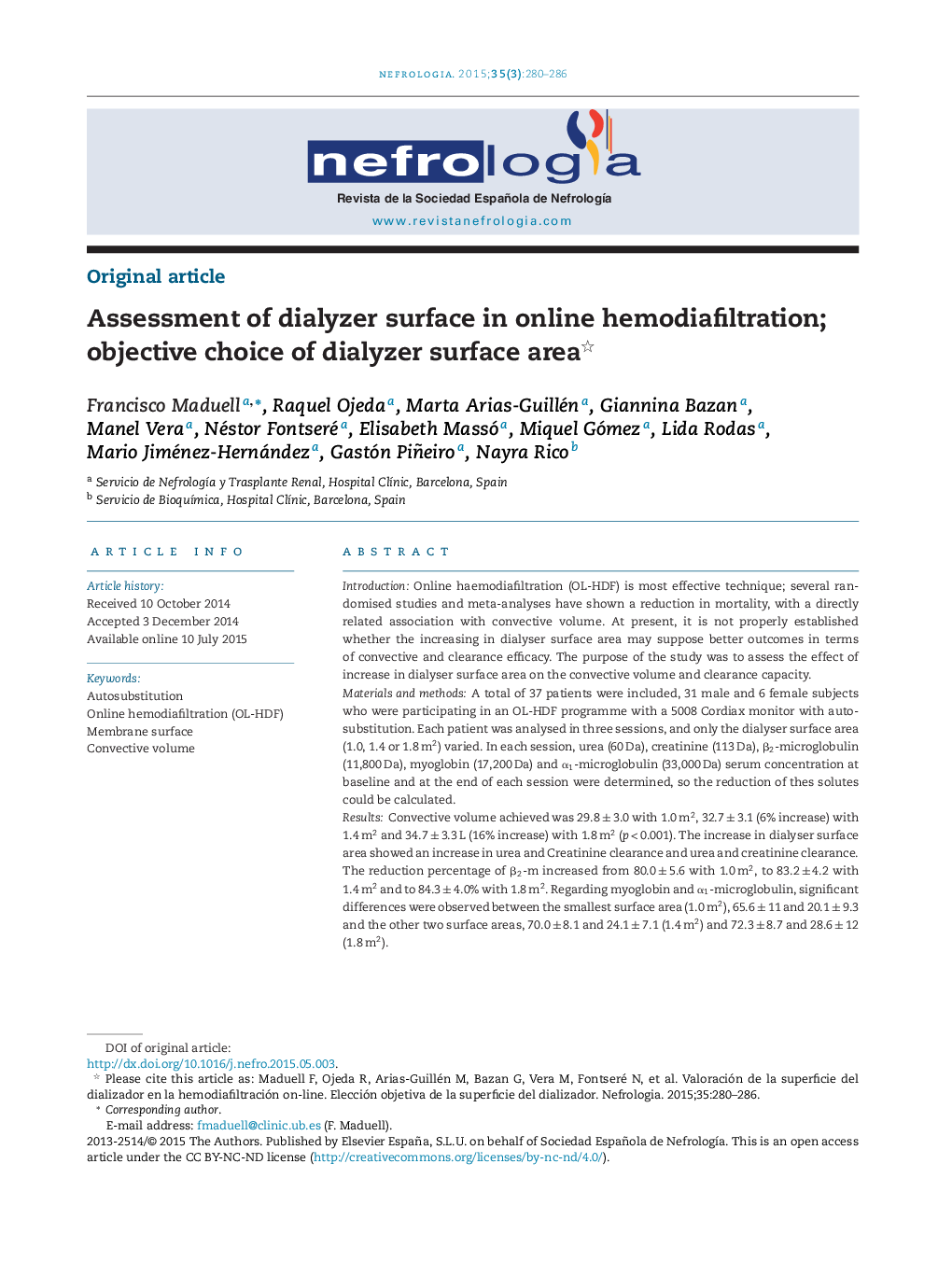| کد مقاله | کد نشریه | سال انتشار | مقاله انگلیسی | نسخه تمام متن |
|---|---|---|---|---|
| 3892586 | 1250077 | 2015 | 7 صفحه PDF | دانلود رایگان |

IntroductionOnline haemodiafiltration (OL-HDF) is most effective technique; several randomised studies and meta-analyses have shown a reduction in mortality, with a directly related association with convective volume. At present, it is not properly established whether the increasing in dialyser surface area may suppose better outcomes in terms of convective and clearance efficacy. The purpose of the study was to assess the effect of increase in dialyser surface area on the convective volume and clearance capacity.Materials and methodsA total of 37 patients were included, 31 male and 6 female subjects who were participating in an OL-HDF programme with a 5008 Cordiax monitor with autosubstitution. Each patient was analysed in three sessions, and only the dialyser surface area (1.0, 1.4 or 1.8 m2) varied. In each session, urea (60 Da), creatinine (113 Da), β2-microglobulin (11,800 Da), myoglobin (17,200 Da) and α1-microglobulin (33,000 Da) serum concentration at baseline and at the end of each session were determined, so the reduction of thes solutes could be calculated.ResultsConvective volume achieved was 29.8 ± 3.0 with 1.0 m2, 32.7 ± 3.1 (6% increase) with 1.4 m2 and 34.7 ± 3.3 L (16% increase) with 1.8 m2 (p < 0.001). The increase in dialyser surface area showed an increase in urea and Creatinine clearance and urea and creatinine clearance. The reduction percentage of β2-m increased from 80.0 ± 5.6 with 1.0 m2, to 83.2 ± 4.2 with 1.4 m2 and to 84.3 ± 4.0% with 1.8 m2. Regarding myoglobin and α1-microglobulin, significant differences were observed between the smallest surface area (1.0 m2), 65.6 ± 11 and 20.1 ± 9.3 and the other two surface areas, 70.0 ± 8.1 and 24.1 ± 7.1 (1.4 m2) and 72.3 ± 8.7 and 28.6 ± 12 (1.8 m2).ConclusionThe increase in 40% and 80% of dialyzer surface area entails an increase in convective volume of 6 and 16% respectively, showing minimal differences both in convective volume and clearance capacity when UFC was greater than 45 mL/h/mmHg. It is advisable to optimise dialyser efficiency to the smallest surface area possible, adjusting treatment prescription.
ResumenIntroducciónLa hemodiafiltración on-line (HDF-OL) es actualmente la técnica más efectiva. Varios estudios aleatorizados y metaanálisis han observado una reducción de la mortalidad, objetivándose una asociación en relación directa con el volumen convectivo. En el momento presente no está bien establecido si el aumento de superficie del dializador puede suponer mejores resultados en términos de eficacia convectiva y depurativa. El objetivo del estudio fue valorar el efecto del aumento de superficie del dializador sobre el volumen convectivo y la capacidad depurativa.Material y métodosSe incluyeron 37 pacientes (31 varones y 6 mujeres) que se encontraban en programa de HDF-OL con monitor 5008 Cordiax con autosustitución. Cada paciente fue analizado en 3 sesiones en las que solo se varió la superficie del dializador (1,0, 1,4 o 1,8 m2). En cada sesión se determinaron la concentración de urea (60 Da), creatinina (113 Da), β2-microglobulina (11.800 Da), mioglobina (17.200 Da) y α1-microglobulina (33.000 Da) en suero al inicio y al final de cada sesión, para calcular el porcentaje de reducción de estos solutos.ResultadosEl volumen convectivo alcanzado fue de 29,8 ± 3,0 con 1,0 m2, de 32,7 ± 3,1 (incremento del 6%) con 1,4 m2 y de 34,7 ± 3,3 l (incremento del 16%) con 1,8 m2 (p < 0,001). El incremento de la superficie del dializador mostró un aumento de la dosis de diálisis y de la depuración de urea y creatinina. El porcentaje de reducción de β2-microglobulina se incrementó de 80,0 ± 5,6 con 1,0 m2, a 83,2 ± 4,2 con 1,4 m2 y a 84,3 ± 4,0% con 1,8 m2. Respecto a la mioglobina y la a1-microglobulina, se observaron diferencias significativas entre la menor superficie (1,0 m2) 65,6 ± 11 y 20,1 ± 9,3; y las otras 2 superficies 70,0 ± 8,1 y 24,1 ± 7,1 (1,4 m2) y 72,3 ± 8,7 y 28,6 ± 12 (1,8 m2).ConclusiónEl incremento del 40 y el 80% de la superficie conlleva un aumento del volumen convectivo de un 6 y un 16%, respectivamente, mostrando mínimas diferencias tanto en el volumen convectivo como en la capacidad depurativa cuando el CUF era superior a 45 ml/h/mmHg. Es recomendable optimizar el rendimiento de los dializadores a la mínima superficie posible adecuando la prescripción de tratamiento.
Journal: Nefrología (English Edition) - Volume 35, Issue 3, May–June 2015, Pages 280–286